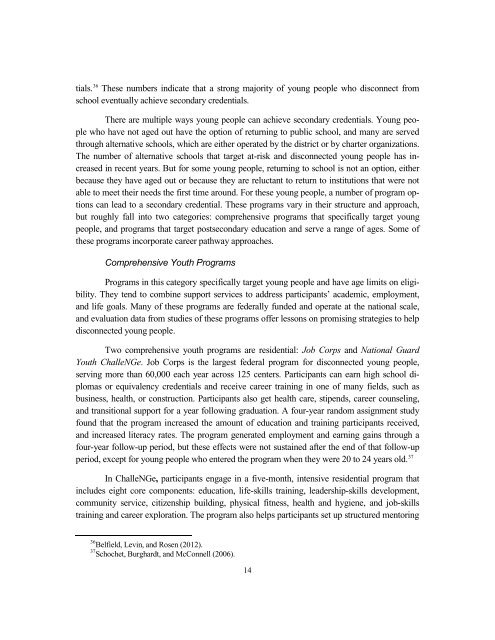Opportunity Youth: Disenfranchised Young People
Opportunity Youth: Disenfranchised Young People
Opportunity Youth: Disenfranchised Young People
Create successful ePaper yourself
Turn your PDF publications into a flip-book with our unique Google optimized e-Paper software.
tials. 36 These numbers indicate that a strong majority of young people who disconnect from<br />
school eventually achieve secondary credentials.<br />
There are multiple ways young people can achieve secondary credentials. <strong>Young</strong> people<br />
who have not aged out have the option of returning to public school, and many are served<br />
through alternative schools, which are either operated by the district or by charter organizations.<br />
The number of alternative schools that target at-risk and disconnected young people has increased<br />
in recent years. But for some young people, returning to school is not an option, either<br />
because they have aged out or because they are reluctant to return to institutions that were not<br />
able to meet their needs the first time around. For these young people, a number of program options<br />
can lead to a secondary credential. These programs vary in their structure and approach,<br />
but roughly fall into two categories: comprehensive programs that specifically target young<br />
people, and programs that target postsecondary education and serve a range of ages. Some of<br />
these programs incorporate career pathway approaches.<br />
Comprehensive <strong>Youth</strong> Programs<br />
Programs in this category specifically target young people and have age limits on eligibility.<br />
They tend to combine support services to address participants’ academic, employment,<br />
and life goals. Many of these programs are federally funded and operate at the national scale,<br />
and evaluation data from studies of these programs offer lessons on promising strategies to help<br />
disconnected young people.<br />
Two comprehensive youth programs are residential: Job Corps and National Guard<br />
<strong>Youth</strong> ChalleNGe. Job Corps is the largest federal program for disconnected young people,<br />
serving more than 60,000 each year across 125 centers. Participants can earn high school diplomas<br />
or equivalency credentials and receive career training in one of many fields, such as<br />
business, health, or construction. Participants also get health care, stipends, career counseling,<br />
and transitional support for a year following graduation. A four-year random assignment study<br />
found that the program increased the amount of education and training participants received,<br />
and increased literacy rates. The program generated employment and earning gains through a<br />
four-year follow-up period, but these effects were not sustained after the end of that follow-up<br />
period, except for young people who entered the program when they were 20 to 24 years old. 37<br />
In ChalleNGe, participants engage in a five-month, intensive residential program that<br />
includes eight core components: education, life-skills training, leadership-skills development,<br />
community service, citizenship building, physical fitness, health and hygiene, and job-skills<br />
training and career exploration. The program also helps participants set up structured mentoring<br />
36 Belfield, Levin, and Rosen (2012).<br />
37 Schochet, Burghardt, and McConnell (2006).<br />
14

















